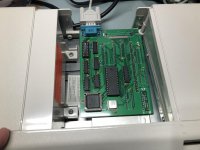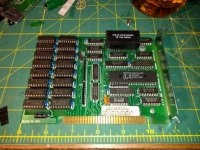bladamson
Veteran Member
Positive pressure on the inside of the enclosure.
Keeps the magic blue smoke in the chips. :3
Keeps the magic blue smoke in the chips. :3
| VCF West | Aug 01 - 02 2025, | CHM, Mountain View, CA |
| VCF Midwest | Sep 13 - 14 2025, | Schaumburg, IL |
| VCF Montreal | Jan 24 - 25, 2026, | RMC Saint Jean, Montreal, Canada |
| VCF SoCal | Feb 14 - 15, 2026, | Hotel Fera, Orange CA |
| VCF Southwest | May 29 - 31, 2026, | Westin Dallas Fort Worth Airport |
| VCF Southeast | June, 2026 | Atlanta, GA |


View attachment 57177
My first prototype of my 3-in-1 board arrived yesterday, and I quickly assembled one. It turns out that the footprint for my CF card slot was completely wrong for the part, so I did not assemble the XT-IDE portion of the board. I also apparently put the PLUS connector 2mm too far to the left, shifting the whole board to the right, so I needed to trim the board slightly to make it fit... but hey, that is what prototypes are for.
But, in the meantime, the SRAM and RS232 portions of the board seem to work well, and I am currently working on optimizing the layout to be a little less of a jumble.
View attachment 57177
My first prototype of my 3-in-1 board arrived yesterday, and I quickly assembled one. It turns out that the footprint for my CF card slot was completely wrong for the part, so I did not assemble the XT-IDE portion of the board. I also apparently put the PLUS connector 2mm too far to the left, shifting the whole board to the right, so I needed to trim the board slightly to make it fit... but hey, that is what prototypes are for.
But, in the meantime, the SRAM and RS232 portions of the board seem to work well, and I am currently working on optimizing the layout to be a little less of a jumble.
Looks nice, but you've got the external connectors on the wrong side of the board.This only matters if you intend to have anything on top of it.
By the way, what are you guys using for UART controllers? I've got an ISA multi-I/O card that I'm using for now, but I should probably work the RS232 into another card at some point to get rid of that annoying PLUS to ISA cable arrangement.
By the way, what are you guys using for UART controllers? I've got an ISA multi-I/O card that I'm using for now, but I should probably work the RS232 into another card at some point to get rid of that annoying PLUS to ISA cable arrangement.
Huh, I had forgotten about the clock chip.. my HX already has one installed. I could go back and implement it into my next prototype, but honestly, it has very limited use for games of the era.
I decided to go the Monotech XT-CF route on my next prototype, and use an IDE to CF adapter mounted "upside down" to get the CF interface. Those are cheaper than buying the sockets themselves new, and are less of a headache than surface mounting them with their 0.635mm pitch. I do not have any problems drag soldering 0.635 surface mount chips, but the CF sockets are always a pain for some reason.. It will require some modification of the backplate, but I still think it kills two birds with one stone by providing a backplate at the same time as fixing my CF socket issues.
Hopefully there's enough people out there who need EX/HX expansion cards to absorb a few different designs, otherwise I'm going to have a bunch of nice PCB coasters lying around.
but what would one realistically install into an EX/HX that isn't already on this?
Hopefully there's enough people out there who need EX/HX expansion cards to absorb a few different designs, otherwise I'm going to have a bunch of nice PCB coasters lying around.
I'm mainly messing about with my design for fun and learning - I'm not going to muddy the waters with another product. I'm happy to keep making my various simple adapters as long as folk want them - tbh I barely have the time to build those these days. :D
I am trying to dream up a way to design my eventual printed board such that it has an ISA edge connector (for standard PC/XT systems), but also has a spot where an optional PLUS header can be soldered in. The ISA edge connector would have a perforated spot where it could be scored with a box knife and broken off on a bench edge, to make it fit in the EX/HX after the PLUS header is added. Although with as cheap as it is to produce boards in small quantities nowadays, I wonder if such a design would really be practical.
Heh. Yeah, I mostly just imagine it'd be nice to just be able to unload a few to recover a bit of what I spent over the saga and keep them from going to waste; the idea of going all-in on making a side business of it fills me with a bit of existential dread. Inventory management for parts alone looks like a non-trivial challenge.
That's easy, just include the Plus header and utilize my Riser Card which has the correct ISA spacing:
https://www.tindie.com/products/cyberneticsys/tandy-1000-ex-hx-plus-isa-riser-card/
Yeah, I guess you really don't lose any board space with your riser, do you? I was coming at it from the angle of "gotta cram in as much as I can in a limited footprint", heh.
Now if we could just find something that could be made into a functional and not-too-ugly PLUS bracket, we'd be all set eh? I've been known to make stuff like that with an improvised sheet-metal brake, a band saw, a drill press, and a set of taps, but I'd hate to do that for something that had to be made in quantities larger than one. D:
I am trying to dream up a way to design my eventual printed board such that it has an ISA edge connector (for standard PC/XT systems), but also has a spot where an optional PLUS header can be soldered in. The ISA edge connector would have a perforated spot where it could be scored with a box knife and broken off on a bench edge, to make it fit in the EX/HX after the PLUS header is added. Although with as cheap as it is to produce boards in small quantities nowadays, I wonder if such a design would really be practical.
Inventory mgmt is a total PITA, I suffer from that issue frequently.
